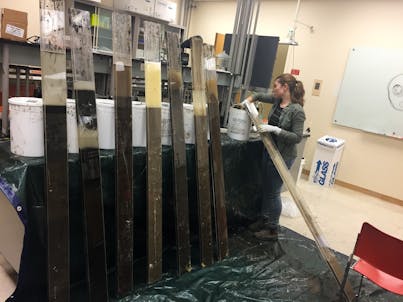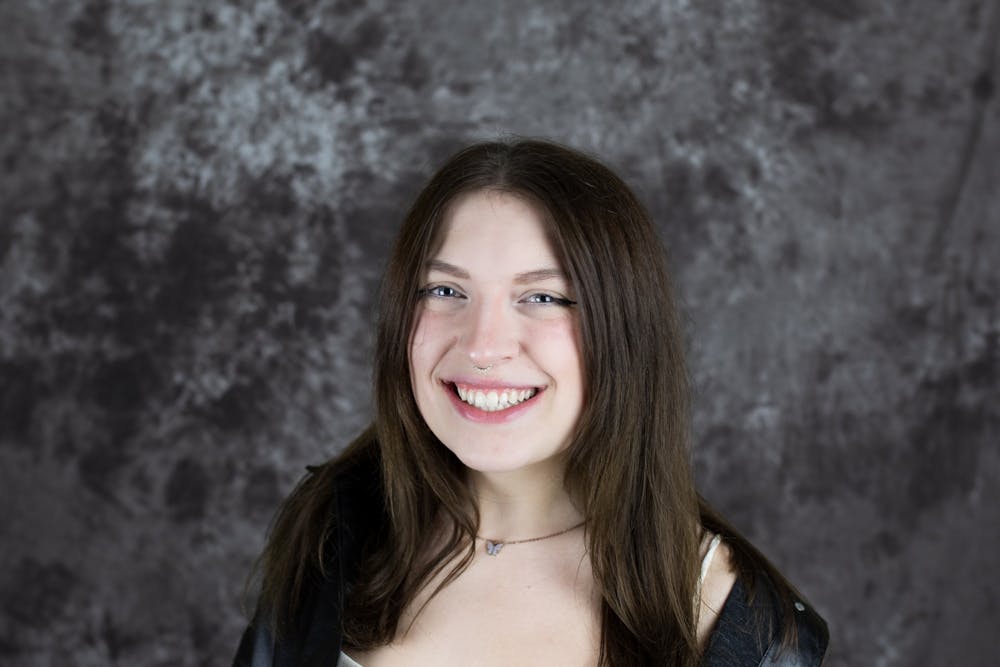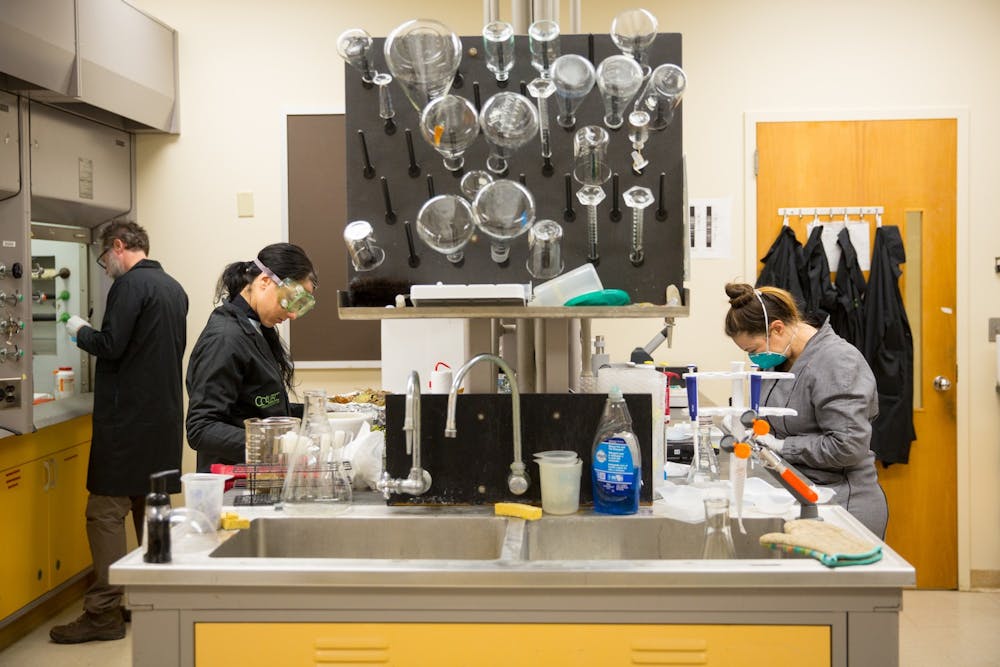Walker Tufts spends his days placing his face in dirt.
While most people tend to avoid exposing their body’s most delicate skin to soil, Tufts has embraced this unconventional action.
Why?
For art and science, of course.
“Faceplant,” as Tufts named his project, represents an experiment in transferring facial bacteria to soil, and vice versa. But it’s also an exploration of the philosophy behind cleanliness, and the manner in which “dirt” represents a kind of “ungodliness,” Tufts told The Spectrum in an interview.
Tufts, a Master of Fine Arts candidate, isn’t alone in examining the intersection of art, philosophy and science.
He is just one part of an entire lab dedicated to this collision of disciplines.
Coalesce BioArt Lab, located in Hochstetter Hall, is part of the Genome, Environment and Microbiome Community of Excellence, established in 2015. Directed by professor Paul Vanouse and managed by Solon Morse, the lab began as an “audacious” attempt to bring artists together in an interdisciplinary space. The lab’s original and continuing purpose is to provide possible solutions to problems such as climate change, global pollution and the ethical dilemmas that come with these issues. Now, the lab, one of only a few of its kind in the world, hosts courses in biological art, outreaches to the Buffalo community and supports multiple international residencies.
Vanouse’s vision for a bioart center in Buffalo sprang from international inspiration. After completing a residency at SymbioticA, which Vanouse affectionately dubs as Coalesce’s “big sister” in Perth, Australia, and then another residency in Helsinki, Finland, Vanouse knew that Buffalo, too, could become a centerpoint of bioart innovation.
When former provost, Charles Zukoski, put out a call for “communities of excellence” — academic spaces that would focus on “leadership and creative engagement” — as part of the UB 2020 plan, Vanouse understood that this was his opportunity to create that innovative space using his own experience with bioart labs.
“I have these really good models before me, but still it feels there is something really interesting about knowing that [Coalesce] exists here,” Vanouse said. “That wasn’t inevitable. That happened because of a really nice kind of convergence of the way in which the university was looking to reward innovation.”
Vanouse was not new to the bioart scene when Coalesce first began to plant its roots on UB’s North Campus. For years, Vanouse utilized biological processes and concepts such as electrophoresis and the polymerase chain reaction (PCR) to create artwork that centered on DNA and DNA imaging.
However, with the creation of Coalesce, Vanouse was able to move his studio from his solitary attic to a place that invited a structure of conversation and philosophizing.
For Laura Marris, Coalesce’s writer in residence and a UB adjunct instructor, this carefully crafted “intellectual climate” has been a source of progression for her current work, a book of essays about landscapes in which “ecological and personal loneliness overlap and inform each other.”
More than that, as a translator, Marris has found the interdisciplinary nature of the lab to be particularly effective in producing creativity and free thinking.
“It’s a special kind of lab that can enable [translation across disciplines] for people,” Marris said. “I think that combination of making and more radical processes of thought is pretty amazing to be around.”
Yet, the benefit of this cross-section between art, biology and writing extends beyond Marris’ own work, and even beyond the lab itself.
Former Coalesce BioArt Lab teaching assistant and UB alum Darya Warner cites the lab as a major reason she obtained her current job teaching photography and art and science collaborative practices at the United States Airforce Academy in Colorado.

“They [the Airforce Academy] wanted someone who would be able to connect different departments,” Warner said. “I’m working with the biology department, the engineering and mechanical departments and building a 3D printer.”
As she implements the skills she learned at Coalesce, Warner recalls her days in Buffalo’s bioart lab with great fondness.
“I felt like I was going there [to the lab] for a date with the love of my life every day in terms of the environment,” Warner said. “[It] was so appealing, and so friendly and understanding and just supportive, you know?”
Warner attributes this “appealing” environment to how encouraging Vanouse and Morse are. She says this enthusiasm is not often found in labs that lack Coalesce’s creative edge, because many other scientists deem certain artistic explorations as “unnecessary.”
“We [artists] are just curious, and just trying to figure out things like the notion of play and ability to be able to use that space,” Warner said.
Now, as Vanouse continues to craft an environment curated to curiosity, he does so with COVID-19 on his mind.
Vanouse says the focuses of artists accepted into the lab tend to follow similar trends with one another. At the moment, Vanouse states there is a particular emphasis on the cultural notions of the gut microbiome. Previous trends have included sustainability and biodegradable living materials.
Though Vanouse has not seen a response to COVID-19 yet in these trend cycles, he hopes to be “proactive” in garnering “pandemic art.”
To do so, he plans on holding workshops that implement viral materials.
“It’s been hard for artists to address this partially because viruses are so tiny,” Vanouse said. “How do you somehow manifest something interesting in the space of a gallery that might involve them?”
As Vanouse and others at Coalesce explore this emerging artwork and response, he promises that harmful viruses will not be used in the lab.
In the meantime, Vanouse is working on his own response to pandemic complications involving Coalesce’s outreach programs.
With COVID-19 restrictions putting a halt to interactions with Buffalo Public Schools, including high schools visiting Coalesce for bioart workshops, Vanouse seeks to keep the lab connected to the Buffalo community.
Part of this direction will involve recruiting a greater number of local Buffalo-based residents to the lab and focusing on the manner in which Coalesce’s interdisciplinary structure can proliferate other areas of UB, Vanouse says.
“There’s all these ways in which learning and knowledge has a material and physical dimension,” Vanouse said. “I want to make this kind of experimental space something which is also available to my colleagues across the institution.”
Kara Anderson is a senior arts editor and can be reached at kara.anderson@ubspectrum.com

Kara Anderson is a senior arts editor at The Spectrum. She is an English and Spanish double major and is pursuing a certificate in creative writing. She enjoys baking chocolate chip cookies, procrastinating with solitaire and binging reality TV on the weekends.





